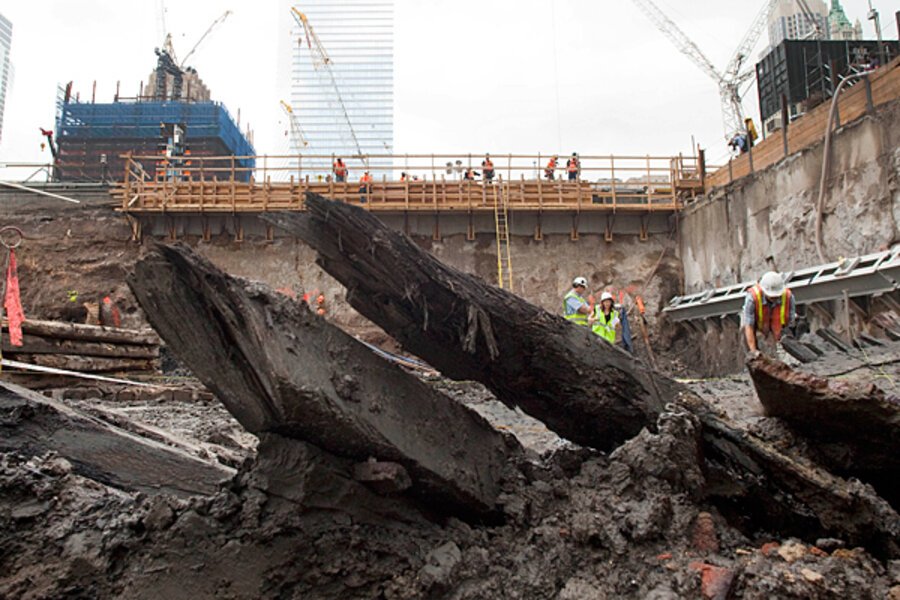Ahoy at the World Trade Center! Ship discovered.
Loading...
| New York
In the late 1700s, the residents of Manhattan Island used their garbage to create more land at the water’s edge.
This week, construction crews working at the World Trade Center site were digging through that old trash – now turned to muck that smells like low tide – and discovered the skeletal remains of a 32-foot vessel. It once plied the local waters, archaeologists think.
“It’s the biggest object so far of historical significance” that’s been found during the rebuilding of the site, says Steve Coleman, a spokesman for the Port Authority of New York and New Jersey, which owns the property.
On Thursday, the port authority let reporters see what was left of the ship at the World Trade Center site. What they saw were timbers that formed the outlines of the vessel, most likely a sailboat. Since the wood is now exposed to the air, consulting archaeologists are trying to figure out how to preserve it.
“It’s very brittle, obviously from being more than 200 years old, and once it’s exposed to air, it gets even more brittle. So they are trying to establish if they can salvage all of it, some of it, or none of it,” Mr. Coleman says.
The remnants were discovered about 30 feet underground. No construction has occurred in that specific location, Coleman says, since Washington Street was built in the early 1800s.
“This is the first time they have excavated in this area, so it’s not surprising there would be things down below,” he says. “Obviously, it’s a piece of New York’s history.”
The remains will be sent to a laboratory, which will try to date the wood, according to some news reports.
Sometimes a lot can be learned from old timbers. Twenty-nine years ago, urban archaeologist Joan Geismar discovered a 92-foot sailing vessel on the East Side of Manhattan, not far from the East River.
When the wood was examined, archaeologists found shipworm casings that had come from the Caribbean. This indicated that the ship, which had gun ports, was probably involved in some sort of commerce with the islands. For whatever reason, the vessel became a derelict and was used to help fill in land prior to 1746.
It’s not surprising to find the hulks of wooden vessels along the shoreline, says Kathleen Hulser, public historian at the New York Historical Society. “The worms were really fierce: There was not enough pollution to kill them,” she says. “If you didn’t scrape the bottom of the boat, it would get rotten really fast.”
When a vessel sank on the shoreline, it sometimes just stayed there, becoming part of the landfill, Ms. Hulser says.
Landfilling was especially important in Manhattan’s history since settlers could buy “underwater” lots. Having an underwater lot gave the owner the right to build a wharf. But, Ms. Hulser says, a lot of clever owners built out the land between wharves, creating new property for themselves.
“I’m not saying it happened in this piece of land [at the World Trade Center site]. We don’t know it all,” she says.
Finding the vessel is not surprising, Ms. Geismar says. “I’m sure there are ships all along the river coast,” she says. “I wouldn’t be surprised if there were Indian canoes.”
Unlike some archeological discoveries, this one is not considered so earthshaking that it would cause construction to halt at the site. Not far from the ship remnants, bulldozers moved earth around for what will become the vehicle security center. This is where buses, trucks, and cars will be examined before they are allowed into underground areas.
The World Trade Center site is filled with construction cranes and workers. One World Trade Center is now built to the 30th floor. Twin pools, which will be part of the 9/11 memorial, have been fully formed. The Memorial Plaza is still on track to open in time for the 10th anniversary of the attack next year, Coleman says, and the World Trade Center museum will be ready in 2013.
“We’re going ahead full throttle,” says Coleman.
Related:





